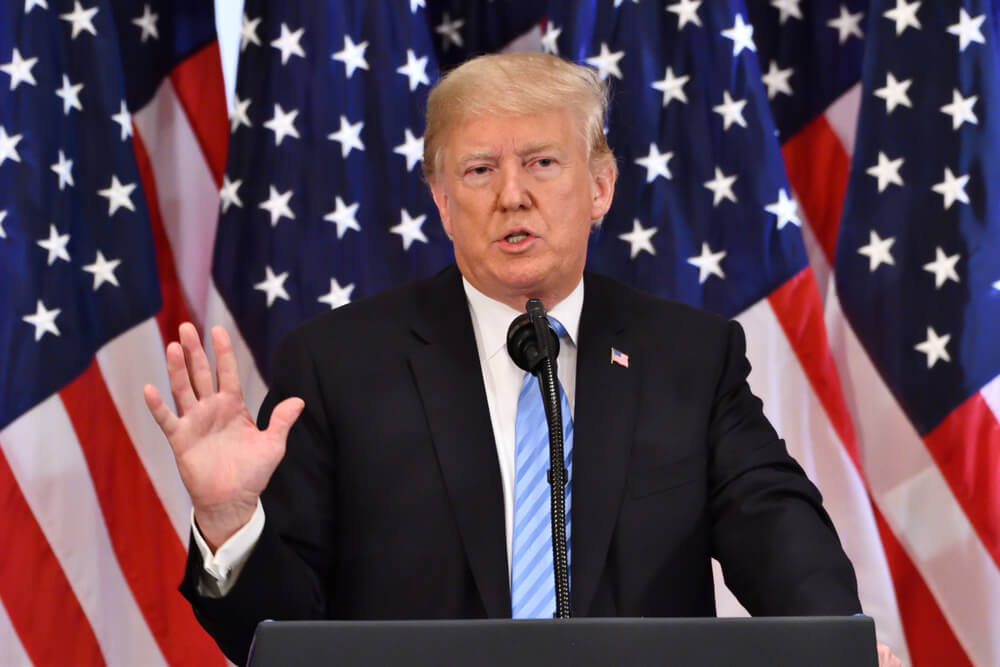The numbers don’t lie: President Donald Trump has been great for business, great for jobs and great for the economy.
However, there is one campaign promise he has failed to deliver on — so far — and that’s the ballooning national debt.
Candidate Trump, the self-described “king of debt,” insisted he would wipe out the United States’ $19-plus trillion (at the time) in debt “over a period of eight years.”
President Trump, on the other hand, according to his own budget office, will have added $9.1 trillion, pushing the debt to $29 trillion, during that time (it’s currently over $22 trillion). And people are taking notice as #DeficitDon was trending nationally on Twitter on Tuesday morning.
Trump even reportedly said he doesn’t care about the national debt because he won’t be in office when the bubble bursts.
From a Dec. 5, 2018 story here on MoneyandMarkets.com:
Sources close to the president say he has repeatedly shrugged (the debt) off, implying that he doesn’t have to worry about the money owed to America’s creditors — currently about $21 trillion — because he won’t be around to shoulder the blame when it becomes even more untenable.
The friction came to a head in early 2017 when senior officials offered Trump charts and graphics laying out the numbers and showing a “hockey stick” spike in the national debt in the not-too-distant future. In response, Trump noted that the data suggested the debt would reach a critical mass only after his possible second term in office.
“Yeah, but I won’t be here,” the president bluntly said, according to a source who was in the room when Trump made this comment during discussions on the debt.
When he said he’d get rid of the country’s debt in eight years, most economists said that was impossible because it would require cutting about $2 trillion a year out of the $4 trillion annual budget to pay off U.S. debt holders.
How did he plan to eliminate the debt?
- He promised 6% GDP growth before lowering that estimate to between 3.5% and 4% once in office.
- New trade deals, which have yet to come to fruition in regard to China, the world’s second-largest economy behind only the United States. Congress also has yet to pass the USMCA trade deal between the U.S., Canada and Mexico.
Trump’s fiscal 2020 budget lowered the annual growth rates even further, between 2.4% and 2.9%. Experts say 2-3% growth is the sweet spot because when it is higher, inflation becomes a problem.
The economy grew at 2.2% his first year in office, jumping to 2.9% in 2018 and hitting 4.2% during the second quarter after the Tax Cuts and Jobs Act — which some will argue helped blow up the debt — had gone into effect. However, it fell to 3.4% in Q3 and back down to 2.2% in Q4 of 2018.
The Q1 GDP for 2019 surprised many, coming in at 3.1% even after a record-long government shutdown. Though, a big slowdown is expected for Q2 numbers, with the Commerce Department’s first estimate released this Friday (we’ll have it covered here Friday morning).
With news breaking this week of a bipartisan, two-year agreement to lift the debt ceiling, one thing is clear: Federal government spending is only going to ramp up even further, sending the national debt soaring even higher.
The deal, announced Monday, will restore the government’s ability to borrow and pay bills past the 2020 elections, building upon budget gains for the Pentagon and other domestic agencies.
….This was a real compromise in order to give another big victory to our Great Military and Vets!
— Donald J. Trump (@realDonaldTrump) July 22, 2019
The deal hasn’t yet cleared Congress but under the new agreement, Republicans have secured $738 billion in defense spending for 2020, and $741 billion for 2021, while Democrats got $632 billion in 2020 and $635 billion in 2021 for domestic spending.
That adds up to about a $320 billion uptick in spending over the next two years, according to Bloomberg.
The Democrats, under House Speaker Nancy Pelosi, have managed to increase domestic spending by more than $100 billion since Trump took office.
So where are the fiscal conservatives and deficit hawks?
Well, they have political incentives to forget about the growing debt, too.
The new deal helps safeguard Trump’s strongest reelection asset: the U.S. economy. And with the new deal, concerns on Wall Street over the government hitting the debt ceiling are now delayed past the 2020 election. Gone, too, are any threats of spending cuts at the end 2019, which would hurt GDP growth — and Trump’s reelection chances.
The Trump administration has reportedly sought spending cuts, which have largely been ignored on both sides of the aisle. The new budget deal ends any efforts to cut the budget until Trump’s second term — or when a Democrat takes office. And if Trump loses the next election, Republicans will use future spending cuts like a straight jacket on a Democrat president.
Adam Jentleson, former Deputy Chief of Staff to Harry Reid, pointed this out on Twitter.
In 2011 Republicans used the debt ceiling to cripple Obama and impose trillions in cuts. Today, Dem leaders agreed to lift the debt ceiling for the remainder of Trump’s presidency but reimpose it in 2021, when Republicans could again use it to cripple a Democratic president. https://t.co/fHH2m25IkB
— Adam Jentleson ???????? (@AJentleson) July 22, 2019
Republicans also were quick to laud increased defense spending (though Ron Paul would surely argue that further feeding the military-industrial complex isn’t the best idea).
“We cannot underestimate the incredible benefit of funding our troops on time for the second year in a row, something Congress hasn’t done in recent memory,” said Mac Thornberry, the ranking Republican on the House Armed Services Committee.
There are some Republicans, however, who do not approve of the new spending deal.
Budget deal. pic.twitter.com/PHa754iGRJ
— Rep. Mark Walker (@RepMarkWalker) July 22, 2019
- “With more than $22 trillion in debt, we simply cannot afford deals like this one,” said Representative Mike Johnson, the head of the conservative Republican Study Committee caucus, according to Bloomberg. “With more than $22 trillion in debt, we simply cannot afford deals like this one.”
- “While this deal is not perfect, compromise is necessary in divided government,” said House Minority Leader Kevin McCarthy, R-Calif.
The measure would first advance through the House this week and win the Senate’s endorsement next week before Congress takes its annual August recess. Legislation to prevent a government shutdown would follow in September.
Take our poll and share your thoughts below in the comments.
[totalpoll id=”12905″]
The Associated Press contributed to this report.




